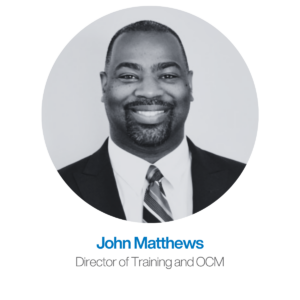
“The technology you use impresses no one. The experience you create with it is everything.” – Sean Gerety – Executive Director, National Right to Work Committee
Technology indeed propels progress, but its value is not in its complex inner workings. Tech brings value when it enables human experiences.
Sean Gerety’s insightful quote above gets at this idea so well. That’s the essence of “training for outcomes” – a perspective shift that stops viewing training as a flat, knowledge-transfer exercise, and instead treats business education as a dimensional, strategic catalyst to drive results.
In the world of enterprise software, mistaking a glossy technology’s capabilities with end user competencies is all too common. A training-for-outcomes mentality helps avoid that error.
The Imperative of Purpose-Driven Training
Traditional training approaches tend to focus on sharing knowledge without connections to practical business goals – or even without bothering to track whether end users master the concepts.
Numerous studies, including research by the National Center on the Educational Quality of the Workforce (EQW), highlight the direct correlation between workforce education levels and productivity gains – a 10% increase in education can lead to an 8.6% boost in overall productivity.
Crafting a Roadmap for Success
To unleash the full potential of training for outcomes, organizations must carefully design processes that interweave training initiatives with their strategic goals:
- Needs Assessment: Identify the specific skill and knowledge gaps training should address, ensuring alignment with the organization’s objectives.
- Curriculum Design: Tailor the curriculum to bridge the identified gaps, striking a balance between informational depth and practical relevance, enhancing the training’s applicability.
- Delivery Methods: Embrace a hybrid approach, blending traditional methods with digital platforms, catering to diverse learning styles and needs.
- Evaluation and Feedback: Post-training evaluations are crucial to measuring the program’s efficacy. They use various metrics to assess knowledge transfer and its impact on performance.
Data: The Guiding Light
Data is pivotal in optimizing training effectiveness, offering necessary insights, and informing continuous improvement. These are crucial processes:
- Training Analytics: Utilize analytics to assess the impact of training programs, focusing on metrics like completion rates and assessment scores to refine the training approach.
- Performance Monitoring: Continuously monitor post-training performance to gauge the application of learned skills in real-world scenarios.
- Iterative Improvement: Use data-driven insights to iteratively enhance the training content and methodologies, ensuring they remain aligned with evolving business needs.
Technology: The Enabler
The good news is that technological advancements in the learning sector can support our training for outcomes. Learning Management Systems, e-learning platforms, and AI-driven adaptive learning paths personalize and align the learning experience with individual and organizational goals. But once again, acquiring a shiny object is not the objective. Select tools with the end of your colleagues’ needs and abilities in mind.
Cultivating a Culture of Continuous Learning
The organizational culture around business learning is critical and has a massive influence on training engagement. A culture that prioritizes continuous learning and knowledge sharing and views training as a critical driver of success is rare. But is the foundation for end-user success with new concepts.
This posture of constant professional development must be modeled at all levels of the organization. Leaders are indeed learners. The team must have structured time to encounter new ideas, and clear performance goals linked to training-guided changes in work behavior.
The Path to Success
Training for outcomes is a strategic imperative that aligns training efforts with organizational objectives, driving success. Organizations can enhance user competence and achieve desired outcomes by crafting well-designed processes, leveraging data-driven insights, integrating technology, and fostering a supportive culture.
In an era of continuous evolution and competition, the ability to effectively train and develop competencies is not merely an advantage but a necessity, paving the way for sustainable growth and success.








 Having been involved in organization change management for over 10 years across multiple industries, I wanted to share my experiences to assist fellow change managers in the never-ending fight for change.
Having been involved in organization change management for over 10 years across multiple industries, I wanted to share my experiences to assist fellow change managers in the never-ending fight for change.


